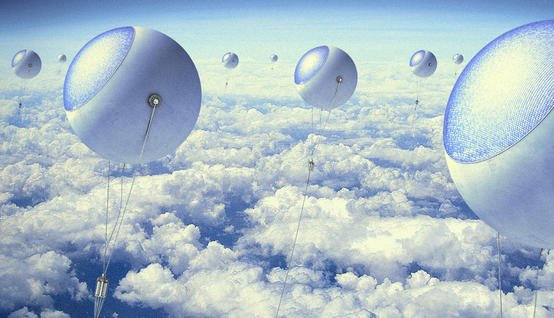
A solar ballon concept. Picture: E. Jullien/pixscience
High altitude solar balloons deployed where clouds won’t interfere with their output may be the stuff of science fiction. But are they? At least one reputable research house thinks this is where solar panels should be, saving space used for solar farms for much needed agricultural land. All while more than doubling solar conversion efficiency.
The NextPV research laboratory, a joint French/Japanese project designed to implement “next generation” solutions, has floated 🙂 their idea for uninterrupted solar energy production.
“The main problem with photovoltaic energy is that sunlight can be obscured by clouds, which makes electrical production intermittent and uncertain. But above the cloud cover, the sun shines all day, every day,” says NextPV’s Professor Jean-François Guillemoles.
“Anywhere above the planet, there are very few clouds at an altitude of 6 km—and none at all at 20 km. Under these conditions, the energy source is five times more abundant than on the ground, and production is entirely predictable. So why not send solar cells up above the clouds …?”
The NextPV team point out that the benefits of placing solar panels above the stratosphere are well worth the effort. According to Prof Guillemoles, more effective conversion — and therefore higher yields — occur where there are no shadows and little diffusion from the atmosphere.
Indeed results from solar cells under concentrated sunlight in the laboratory recently exceeded 45 percent efficiency, according to French high-tech company SOITEC. This compares to the current average of PV cells under normal conditions of around 15 to 20 percent.
The team point out that other balloon projects have already proven successful. One is Google’s strangely-named Project Loon, a visionary program designed to bring the Internet to remote locations where expensive satellite technology has been the only previous Internet option.
Trialled in New Zealand, the so-called Google Balloon Internet project uses solar panels and battery storage to send viable Internet reception to remote farmers and rural dwellers.
While ongoing, the apparent initial success of the Google Balloon Internet project augurs well for NextPV’s high altitude solar balloon network.
It would appear that such “nimble and disruptive” technology would fit nicely here in Malcolm 2.0’s innovative Australia. Not only would we be making use of the vast skies above our land, generating solar cell efficiencies double that of those here on land but also boosting the possibility that we will actually reach the agreements signed in the recent Paris climate agreement.
High altitude solar balloons instead of solar farms and domestic arrays? Or is this all pie in the sky 🙂 Your thoughts please. With that we wish all readers a very merry and safe Christmas and a productive, enterprising, innovative and nimble New Year!

 RSS - Posts
RSS - Posts



Whether it be weather balloons with solar or other innovative technology, the fact is we need alternate energies, whether it be solar, wind or wave power or whatever. I am for all of new ideas to save this planet. But I have noticed there are some in the new technologies have blinkers on saying only the technology they work with is better than others..i.e. solar vs windpower…it is like the old days of electricity and gas competition when electricity was first used…they also had their heads firmly up their rear ends while also buried in the sand. The new technologies should be promoting all forms of alternative energy, e.g…working together, with the same enthusiasm they do with their own. Or we will all suffer in the future.It is bad enough the Liberal Party have (well bar Mr Wonderful, [ alias Turnbull ]well he thinks he is) their respective head up their posteriors too re alternate energies, which isn’t helping future technologies at all.But then conservatives have always been a century behind the rest of the world. Any ideas, of alternative energies, whether it be solar balloons or whatever, should be investigated…if only in the idea stage…remember, solar power was once just an idea…but it was well worth the research as has since been proved.
In order to send any real amounts of electricity from high altitude to ground, a substantial conductor/cable would need to be supported. Presuming an aluminium cable from a balloon 20 km up to a sub-station on high ground, that would possibly be a conductor weighing some thousands of tonnes. Then there would be the issue of wind currents being different at various altitudes, including a jet-stream to consider, multiplying the effect of vertical load. It would want to be an enormous balloon. There must be a way to get the power to ground without that mass.
Nice idea to gain efficiency but will never get off the ground owing to the danger from tether / power feed cables to aircraft and helicopters.
OK How does the power generated get backfown to earthe?
Great discussion thanks folks. Clearly this technology is still on the drawing board with a lot of obstacles still to overcome. I guess it’s whether we have the collective political will to back R&D into resolving these issues.
Thoughts?
Hi High can you park a blimp? That would fit heaps of panels, and only need one tether/feed wire.
…and could a laser transfer enough energy instead of wires?